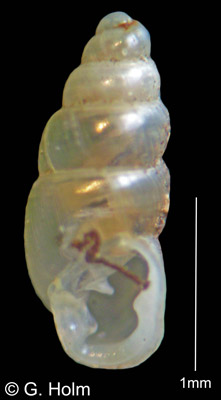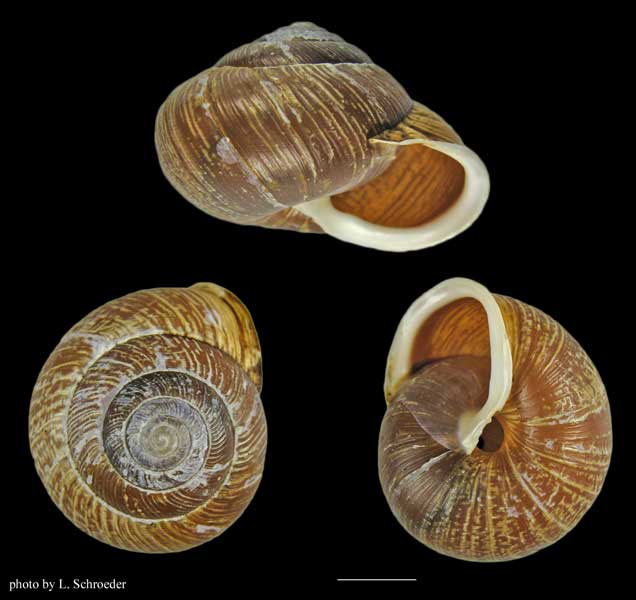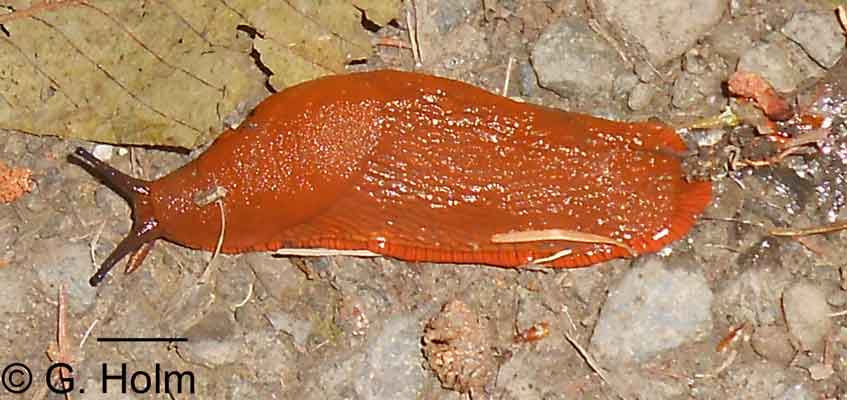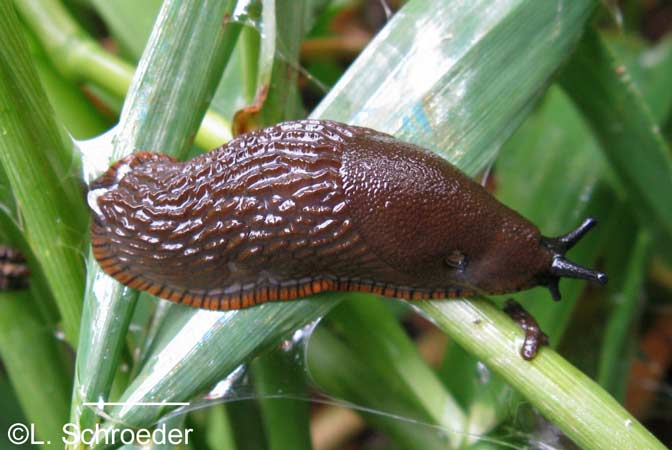
 Assiminea parasitologica Kuroda, 1958
Assiminea parasitologica Kuroda, 1958
Asian Marsh Snail
Lives in salt marshes, introduced & invasive; has been found in several estuaries in Oregon; distinguish from A. californica by the light colored band at the top of each whorl
Pomatiopsidae Cecina manchurica
Cecina manchurica
A. Adams, 1861
Manchurian Cecina
Lives in brackish water (high intertidal),
an introduced species from Japan
Littorinidae


 Littorina subrotundata (Carpenter, 1864)Salt Marsh PeriwinkleLives in salt marshes and at splash zone at high intertidal, native
Littorina subrotundata (Carpenter, 1864)Salt Marsh PeriwinkleLives in salt marshes and at splash zone at high intertidal, native
Assimineidae
 Angustassiminea californica (Tryon, 1865)
Angustassiminea californica (Tryon, 1865)
California Assiminea
Lives in salt marshes, native
 Carychium minimumMüller, 1774Herald Thorn SnailLives in marshes, wet meadows; introduced to BC from Europe
Carychium minimumMüller, 1774Herald Thorn SnailLives in marshes, wet meadows; introduced to BC from Europe

 Carychium tridentatum
Carychium tridentatum
(Risso, 1826)
Slender Thorn Snail
Lives in moist leaf litter,
introduced to BC from Europe Carychium occidentalePilsbry, 1891Western Thorn SnailLives in moist leaf litter, native
Carychium occidentalePilsbry, 1891Western Thorn SnailLives in moist leaf litter, native
Helicidae
 Cepaea nemoralis (Linnaeus, 1758)
Cepaea nemoralis (Linnaeus, 1758)
Banded Garden Snail
Lives in grasslands, woodlands, and urban gardens,
an introduced species from Europe; now widespread in the Northwest
Ellobiidae
 Myosotella myosotis (Draparnaud, 1801)
Myosotella myosotis (Draparnaud, 1801)
European Melampus
Lives in salt marshes,
an introduced species from Europe
Haplotrematidae

 Ancotrema sportella (Gould, 1846)
Ancotrema sportella (Gould, 1846)
Beaded Lancetooth
Lives in damp woodland locations, native
Polygyridae
 Allogona townsendiana (I. Lea, 1838)
Allogona townsendiana (I. Lea, 1838)
Oregon Forestsnail
Lives in woodlands, native
 Cornu aspersum (Müller, 1774)
Cornu aspersum (Müller, 1774)
Brown Garden Snail
An agricultural and garden pest,
an introduced species from Europe, edible;
now widespread in the Northwest
(previous name - Helix aspersa)
Land Snails & Slugs
(Oregon to Southeast Alaska)
Click on photo to enlarge. Scale line in photo equals 1cm unless otherwise specified.
Lauriidae Lauria cylindracea
Lauria cylindracea
(da Costa, 1778)
Common Chrysalis Snail
Lives in gardens, parks and wastelands,
an introduced species to BC from Europe
Cochlicopidae  Cochlicopa lubrica (Müller, 1774)
Cochlicopa lubrica (Müller, 1774)
Glossy Pillar
Lives in urban and wasteland
areas, native
 Oxychilus draparnaudi
Oxychilus draparnaudi
(Beck, 1837)
Dark-bodied Glass-snail
Lives in moist gardens and woodlands
Oxychilidae 

 Oxychilus alliarius (Miller, 1822)
Oxychilus alliarius (Miller, 1822)
Garlic Glass-snail
Lives in moist gardens and woodlands
This page last revised: 6-28-2024
Valloniidae Vallonia pulchella
Vallonia pulchella
(Müller, 1774)
Lovely Vallonia
Lives in urban and agricultural
areas, an introduced species
from the east coast
Invasive Species These three similar looking species are introduced to the U.S. Cernuella virgata
is considered extremely invasive. If one encounters this snail,
it should be reported to the appropriate State Wildlife Dept. The Cepaea is similar in size to the Cernuella and both may be banded, but Cepaea does not have an open umbilicus (hole on the bottom). The Cernuella and Candidula look very much alike but the Candidula does not get as big as Cernuella.
These three similar looking species are introduced to the U.S. Cernuella virgata
is considered extremely invasive. If one encounters this snail,
it should be reported to the appropriate State Wildlife Dept. The Cepaea is similar in size to the Cernuella and both may be banded, but Cepaea does not have an open umbilicus (hole on the bottom). The Cernuella and Candidula look very much alike but the Candidula does not get as big as Cernuella.
Hygromiidae Candidula intersecta (Poiret, 1801)Wrinkled HelicellidAn introduced species from Europe, not yet widespread in the Northwest;
Candidula intersecta (Poiret, 1801)Wrinkled HelicellidAn introduced species from Europe, not yet widespread in the Northwest;
reaches 7-13mm wide, 5-8mm high
 Cryptomastix germana(Gould, 1851)Pygmy OregonianLives in conifer forests in leaf litter and woody debris, native
Cryptomastix germana(Gould, 1851)Pygmy OregonianLives in conifer forests in leaf litter and woody debris, native
Slugs
Arionidae



 Arion rufus (Linnaeus, 1758)Chocolate Arion
Arion rufus (Linnaeus, 1758)Chocolate Arion
Arion rufus is part of the Arion ater/Arion rufus complex, native to Europe. Arion rufus has been introduced to North America and is very common and widespread. The color
can be variable from bright orange to black. The foot may exhibit
a color ranging from yellow to black. Lives in gardens, parks
and wastelands, and can be a serious
plant pest.
Arion ater has been shown to be a separate species. Since the two species were once considered the same, some older references list A. ater as present in the Northwest. This is not the case.
Ariolimacidae 
 Ariolimax columbianus (Gould, 1851)Pacific Banana SlugLives in damp, wooded areas; native; second largest land slug in the world
Ariolimax columbianus (Gould, 1851)Pacific Banana SlugLives in damp, wooded areas; native; second largest land slug in the world
Limacidae

Limax maximus Linnaeus, 1758
Giant Garden Slug
Lives in gardens, along roads, wooded areas
and wastelands; introduced from the
area surrounding the Mediterranean
Vitrinidae
 Vitrina pellucida (Müller, 1774)Western Glass-snail
Vitrina pellucida (Müller, 1774)Western Glass-snail
Lives
under brush, aspen and other hardwood stands. It cannot withdraw
completely into its shell and actually falls into the same superfamily
as many slugs.
Agriolimacidae Deroceras reticulatum (Müller, 1774)Gray Fieldslug
Deroceras reticulatum (Müller, 1774)Gray Fieldslug
Lives in gardens, greenhouses, roadsides and fields; a common garden pest; introduced from western Europe
Primary
reference for this page: Burke, T.E. (2013). Land Snails and Slugs of
the Pacific Northwest. Oregon State University Press.
Citation: Pacific Northwest Shell Club, www.PNWSC.org


 Vespericola columbiana (I. Lea, 1838)
Vespericola columbiana (I. Lea, 1838)
Northwest Hesperian
Lives in woodlands, native
 Cernuella virgata (da Costa, 1778)
Cernuella virgata (da Costa, 1778)
Vineyard Snail
A highly invasive species from Europe,
detected in Tacoma, WA in 2005;
eradication efforts seem to be working;
reaches 8-25mm wide, 6-19mm high
















